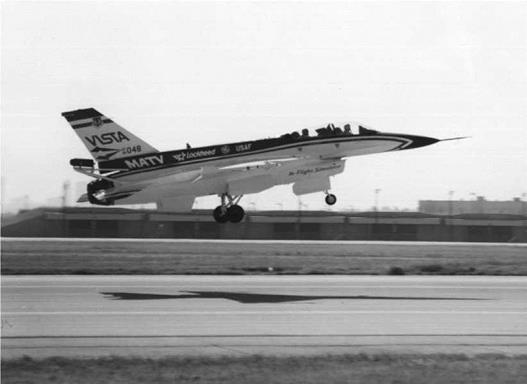The V/STOL Case
Vertical or short takeoff and landing (V/STOL) airplane flying qualities requirements present special problems because V/STOL airplane technology covers a large range of possibilities. So far, we have seen tilt rotor, lift fan, vectored thrust, blown flaps, and convertible rotor wing versions. Although the military services have taken up the challenge and in 1970 issued a V/STOL flying qualities specification, MIL-F-83300, there is a danger that the requirements are specific to individual designs, those available for testing at the time.
MIL-F-83300 recognizes three airspeed regimes, from hover to 35 knots, from 35 knots to an airspeed Vcon where conventional flying qualities requirements apply, and airspeeds above Vcon. Requirements are either for small perturbations about some fixed operating point or for accelerated or transitional flight. The V/STOL small-perturbation longitudinal
|
Figure 3.13 The Air Force Wright Laboratory’s VISTA, or multiaxis thrust-vectoring airplane, a variable-stability machine based on the General Dynamics F-16D. Thrust is vectored up to 17 degrees in pitch and yaw, primarily for high-angle-of-attack research. (From Aerospace America, Dec. 1993) |
dynamics requirements take the familiar MIL-8785 form of acceptable and unsatisfactory boundaries in terms of real and imaginary parts of the system roots. So do the lateral-directional requirements resemble those for conventional airplanes, as requirements on the shape of the bank angle versus time curve for rolls and on permitted adverse yaw.
A complication when applying the familiar period and damping requirements to the roots of V/STOL motions is convergence of the ordinary modes of motion at very low airspeeds. For a powered-lift STOL configuration the longitudinal short-period and phugoid modes merge at an equilibrium weight coefficient, equivalent to the lift coefficient, of 3.5 (Figure 3.14). A similar trend shows up in the lateral case, where an (unstable) spiral mode approaches in time constant the usually much shorter rolling mode at a large value of the equilibrium weight coefficient.
The problem of establishing V/STOL flying qualities requirements that are not tied to specific configurations was taken up again after MIL-F-83300, for the most part with the help of ground simulations and variable-stability airplanes. In 1973, Samuel J. Craig and Robert K. Heffley used analysis and ground simulation to explore the role of thrust vector inclination during STOL landing approaches (Craig and Heffley, 1973).
Still later, in papers delivered in 1982 and 1983, Roger H. Hoh, David G. Mitchell, and M. B. Tischler looked for flying qualities generalizations in VTOL transitions and STOL path control for landings. Precise pitch attitude control at high bandwidth appears to be critical in transitions because of the sensitivity of vertical rate to pitch attitude. However,
|
Figure 3.14 A complicating factor in specifying STOL flying qualities. The long – or phugoid and short-period longitudinal modes converge at low airspeeds, where part of the airplane’s weight is supported by thrust. (From Etkin, Dynamics of Atmospheric Flight, 1972) |
the writers found a number of possible requirements for the landing flare control maneuver of STOL airplanes. That series closed out with a major effort to extend the MIL Prime Standard and Handbook (Anon., 1987) concept to STOL Landings (Hoh, 1987).
An area that seems to require more attention is the lift loss in the vortex ring state (Glauert, 1934; Coyle, 1996) during increases in descent rate. Vortex rings recirculate the rotor downflow back into the rotor, instead allowing it to descend and produce lift. This is a performance problem for single-rotor helicopters. However, for the tilt-rotor V-22 Osprey, a vortex ring on one of two laterally located rotors is believed to have produced an unrecoverable roll.
The considerable experience gained by DERA and BAE systems in V/STOL projects, leading to the Harrier and the VAAC (Vectored thrust Aircraft Advanced flight Control) Harrier, is summarized by Shanks (1996) and Fielding (2000). One key finding was that eliminating conscious mode changing provides a large reduction in pilot work load. The V/STOL becomes a “conventional aircraft that can hover.” Another finding was the need to use closed-loop analysis to specify propulsion system characteristics in terms of bandwidth and response linearity.
Pilot-in-the-loop technology (Chapter 21) has made significant contributions to understanding the special flying qualities requirements of STOL and VTOL airplanes. This approach is especially valuable because it is not closely tied to the design details of specific machines.















